If you’re looking for the best gas for TIG welding, there are a few factors you need to consider before making your decision. Tungsten Inert Gas (TIG) welding is a precision welding process that requires the use of a shielding gas to protect the weld from atmospheric contamination. The type of gas you choose can have a significant impact on the quality of your welds and the overall welding process.
The first factor to consider when choosing a gas for TIG welding is the type of metal you will be welding. Different gases work better with different metals. For example, Argon gas is great for welding aluminum while Helium gas is ideal for welding thicker metals. The second factor is the purity of the gas. High purity gases, such as 99.999% pure Argon, can help improve the quality of your welds. Lastly, you should consider the flow rate and pressure of the gas. These factors can affect the stability of your welding arc and the overall quality of your weld.
Are you struggling to find the best gas for TIG welding? Do you want to know which gas is the most cost-effective or which gas will produce the best results for your specific needs? Or maybe you’re just starting out with TIG welding and want to learn more about which gases to use? Keep reading to find out everything you need to know to choose the best gas for your TIG welding projects.
10 Best Gas For Tig Welding
| # | Product Image | Product Name | Product Notes | Check Price |
|---|---|---|---|---|
|
1
|
This product is ideal for welders using TIG gas lenses 0.020" to 1/8" on various welding torches.
|
|
||
|
2
|
The welding tool is perfect for air-cooled TIG welding with flexible head and gas valve, complete with power cable and hose.
|
|
||
|
3
|
This product is ideal for measuring gas flow in MIG and TIG welding.
|
|
||
|
4
|
It is ideal for regulating gas flow in welding applications such as MIG and TIG.
|
|
||
|
5
|
It is ideal for TIG welding with a flexible head, gas valve, and a complete package including power cable and adapter.
|
|
||
|
6
|
This product is ideal for TIG welding with large diameter jumbo gas lens collet bodies in SR WP 17, 18, and 26 torches.
|
|
||
|
7
|
The product is ideal for TIG welding torches in the 9, 20 and 25 series of popular brands.
|
|
||
|
8
|
This product is ideal for TIG welding with a stubby gas lens, #10 Pyrex glass cup, and WP-17/18/26 torches.
|
|
||
|
9
|
The product is ideal for use in TIG welding torches with large diameters and requires gas lens collet bodies.
|
|
||
|
10
|
It is ideal for fitting various TIG welding torches with gas lens back caps, collet bodies, and assorted size kits.
|
|
1. Riverweld Tig Nozzle Kit: Precision Welding Essential.
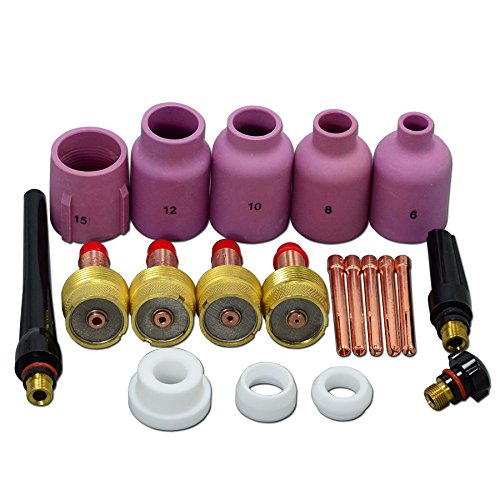
The Fit QQ300 DB PTA SR WP CK 17 18 26 TIG Welding Torch is a high-quality welding torch designed to provide superior performance and durability. This welding torch is ideal for use in a variety of welding applications, including TIG welding, and is compatible with a range of welding machines.
The package includes a set of 5pcs TIG Large Diameter Alumina Gas Lens Nozzles, which are designed to provide a stable and consistent gas flow during welding. These nozzles are made of high-quality alumina material and have a large diameter for improved gas coverage and better weld quality.
In addition, the package also includes 4pcs TIG Large Diameter TIG Gas Lenses, which are designed to provide improved visibility and control during welding. These gas lenses are made of high-quality materials and are highly durable, making them ideal for use in a variety of welding applications.
The package also includes 5pcs TIG Collets Long, which are designed to provide a strong and reliable grip on the tungsten electrode during welding. These collets are made of high-quality materials and are highly resistant to wear and tear, ensuring long-lasting performance.
Furthermore, the package includes 3pcs TIG back caps and 3pcs Gas Lens Gasket Cup Inset back insulators, which are designed to provide improved protection and insulation during welding. These accessories are made of high-quality materials and are highly durable, ensuring long-lasting performance even in demanding welding environments.
2. Weldingcity's Flexi-Torch Tig Welding Package
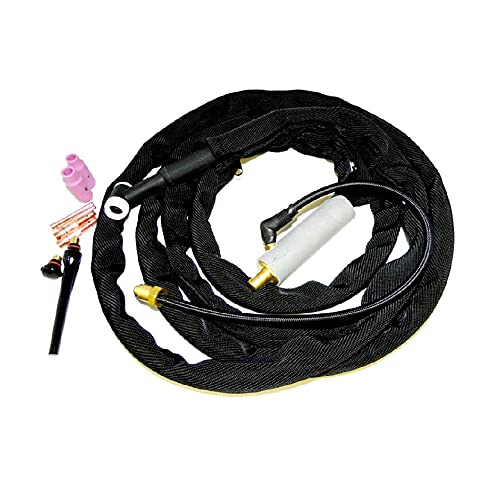
The TIG welding torch is an essential tool for professional welders, and this premium quality 200-amp air-cooled WP-26 complete TIG welding torch package is an excellent choice for those looking for long-lasting and reliable service. The package comes with a 12.5-ft or 25-ft 1-piece EPDM rubber power cable that is shipped as un-assembled for easy transport and handling.
The package includes a 200-amp air-cooled WP-26 series high-quality silicone rubber torch body with a handle. The torch body is designed to withstand extended usage, making it a reliable choice for professional welders. The package also includes a 1-piece type EPDM rubber power cable hose 46V28R (12.5-ft) and 46V30R (25-ft), which is made from high-quality material for durability.
The package includes a nylon cable cover with a zipper, which provides added protection to the power cable. The Dinse 35-50mm solid 1/2"-pin adapter with separate gas hose and accessory kit (1/16" and 3/32" collets, collet bodies, ceramic cups, and back caps) is also included in the package. The adapter is compatible with Miller reference # 195379 and can be used with all mainstream welders on the market, making it an ideal replacement for many other aftermarket or equivalent welders.
The silicone rubber insulated torch bodies are available in four different head types: WP-26 (regular), WP-26F (flexible head), WP-26V (head with gas valve), and WP-26FV (flexible head with gas valve). This allows welders to choose the head type that best suits their application.
The package comes from a U.S.-based welding and hardware supplier, and they offer strong technical support with experienced customer service to address buyer's any question. The package includes all the necessary components required for welding, making it a complete package that is ready to use.
3. Argon Co2 Professional Gas Flow Meter Tester Flowmeter (Peashooter) For Mig Tig Welder Welding
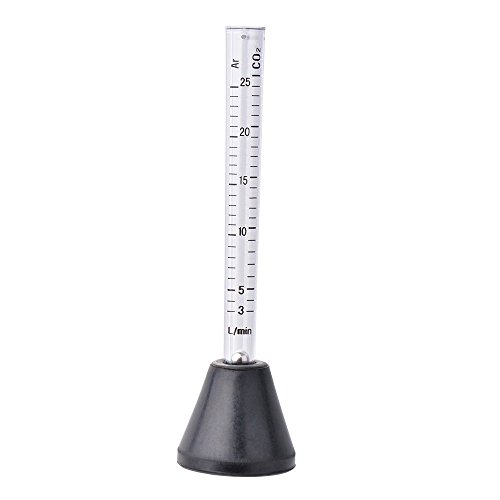
The Professional Ggs Flow Tester / Meter Peashooter Style is an essential tool for anyone working with Mig or Tig torches. With a scale that ranges from 0 to 25 litres per minute in one litre graduations, users can easily and accurately test gas flow rates.
The peashooter-style design allows the tester to be placed over the Mig or Tig gas nozzle, and the gas flow is measured from the top of the ball. This feature ensures that gas flow rates are precisely measured, regardless of the type of gas being used.
This flowmeter tester is specifically designed to check gas flow on Tig or Mig torches, making it a must-have tool for welders, fabricators, and anyone working with these types of torches. It is also 100% brand new and has never been used, so users can be confident in its accuracy and reliability.
4. Agptek Argon Co2 Flow Meter Regulator Hose, Mig Tig, Unf5/8,6.56ft With Inert Gas Fitting
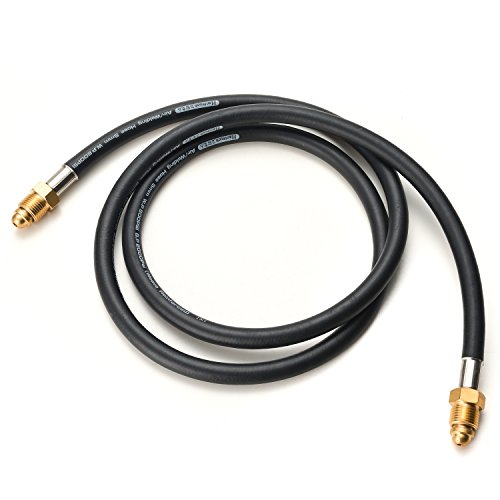
The Professional Flow Meter Regulator Manufacturer is proud to present their Argon Flow Meter, designed to fit Argon, CO2, and Argon/CO2 fixed. This flow meter is suitable for most argon tanks and comes with a rubber hose that is ideal for fitting MIG and TIG welding. The inert gas fitting is perfect for argon welding gas, providing a reliable and efficient flow rate.
The hose length of the Argon Flow Meter is 6.56ft and the hose is standard UNF 5/8". This makes it easy to connect to a variety of welding equipment, including Miller or Lincoln welders. The hose is durable and flexible, ensuring that it can withstand the tough conditions of a welding environment.
Please note that this hose is specifically designed to suit the AGPTEK Argon Flow Meter HF43U. If you are interested in purchasing the regulator together with the hose, please do not hesitate to contact our customer service team who will be happy to assist you.
5. Weldingcity 200-Amp Air-Cooled Tig Torch Complete Package.
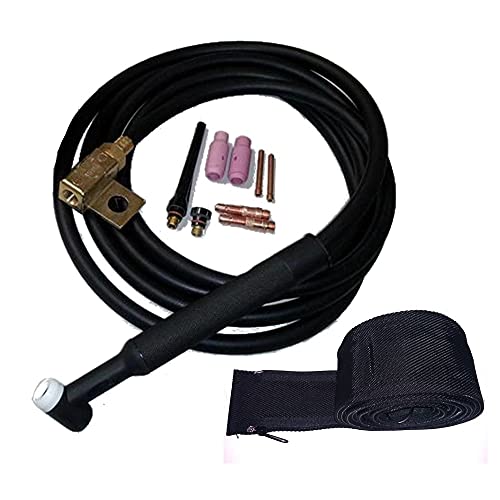
Introducing the Premium Quality 200-Amp Air-Cooled WP-26 Complete TIG Welding Torch Package – an excellent choice for medium to heavy gauge TIG welding applications. This package comes with a 12.5-ft or 25-ft 1-piece EPDM rubber power cable, and is shipped unassembled for easy installation.
The package includes a 200-amp air-cooled WP-26 series high quality silicone rubber torch body with handle, a 1-piece type EPDM rubber power cable hose (46V28R for 12.5-ft or 46V30R for 25-ft), nylon cable cover with zipper, brass cable adapter 45V62, and an accessory kit with 1/16" and 3/32" collets, collet bodies, ceramic cups, and back caps. The package is also available in various head types, such as WP-26 (regular), WP-26F (flexible head), WP-26V (head with gas valve), and WP-26FV (flexible head with gas valve), to suit different welding needs.
The silicone rubber insulated torch bodies are designed to last and provide reliable service. And with the brass cable adapter 45V62, connecting the torch to your gas tank and welding machine with standard 1/2" threaded output stud is quick and easy. This TIG welding torch package is an ideal replacement for mainstream welders on the market, as well as for many other aftermarket or equivalent welders. Please check your TIG welder for matching before making a purchase.
This product is backed by a U.S. based welding and hardware supplier, which provides strong technical support with experienced customer service to address any questions you may have. Please refer to the listed pictures for the torch parts and rear plug.
6. Jumbo Tig Lens For Large Welding Torches.
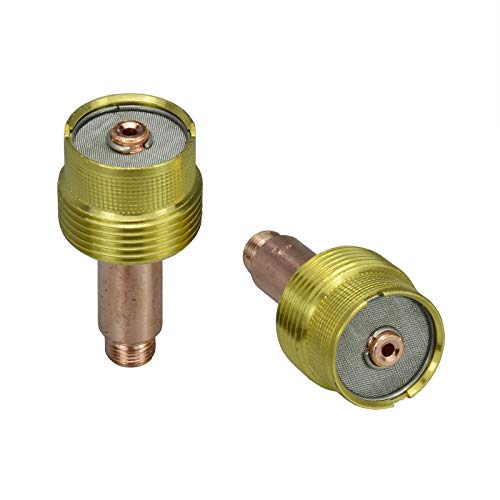
This pack of 2 large diameter TIG gas lens collet bodies is designed to fit perfectly with SR PTA DB WP 17 18 26 TIG welding torches. The collet bodies are compatible with 10N series TIG collets and 57N 53N series ceramic cups, making them a versatile addition to any welding kit.
The collet bodies are designed with a 3/32" and 2.4mm orifice, making them ideal for welding applications that require precision and accuracy. With a size of 3/32" x 2" and 2.4mm x 50mm, these collet bodies are easy to handle and provide a comfortable grip during welding.
Ref No 45V64 is the reference number for these collet bodies. The pack includes two collet bodies, ensuring that you always have a spare on hand when you need it.
These TIG gas lens collet bodies are made from high-quality materials, ensuring durability and longevity. They are easy to install and provide a secure fit, making them a reliable choice for professional welders and DIY enthusiasts alike.
7. Tig Welding Gas Lens Collets – 5 Pack
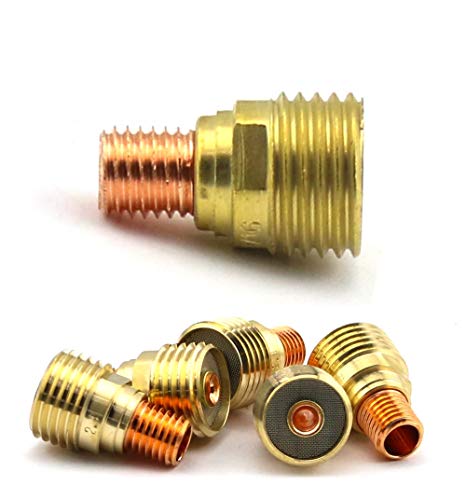
This pack of 5 premium quality gas lens collet bodies, designed for gas-lens setup in TIG welding torches 9, 20 and 25, is an essential addition to any welder's toolkit. These collet bodies can be used with 13N-series collets and 53N-series gas lens ceramic cups in gas lens setups to significantly reduce gas turbulence in the gas-shielding stream.
The gas lens collet body orifices for Tungsten electrodes come in various sizes, including 0.020" (45V41), 0.040" (45V42), 1/16" (45V43), 3/32" (45V44), and 1/8" (45V45). This provides a wide range of options to suit different welding needs.
It's important to refer to your TIG welding torch user manual for the selection of consumable parts. These gas lens collet bodies are suitable for TIG torch amperage ranging from 125A to 250A, whether air-cooled or water-cooled.
This product is a pack of 5 gas lens collet bodies, each with a different orifice size, including 0.020", 0.040", 1/16", 3/32", and 1/8". The pack also includes a volume discount option, which means you can save more if you buy more.
The supplier of this product is based in the U.S., providing strong technical support and experienced customer service to address any questions buyers may have. Overall, this pack of 5 premium quality gas lens collet bodies is an excellent choice for any welder looking for durable and reliable equipment that delivers top-notch results.
8. Rx Weld 55pcs Tig Welding Torch Stubby Gas Lens #10 Pyrex Glass Cup Kit For Wp-17/18/26
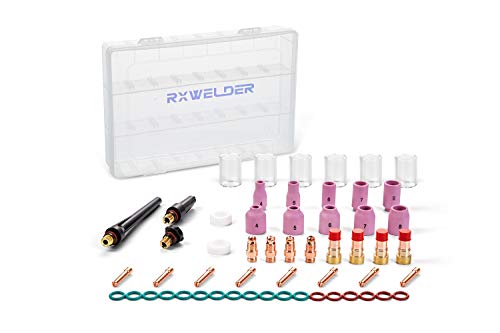
Introducing the 55-pieces TIG Torch Accessories, the ultimate welding consumables for your TIG welding needs. These accessories possess exceptional plasticity, toughness, and crack resistance, including higher low-temperature impact toughness.
These consumables are designed for various locations of pipeline TIG welding arc welding and arc welding, making it a perfect solution for welding joints. They are capable of welding carbon steel and some low alloy steel, making it an excellent addition to any welding kit.
Region-free and easy to use, these consumables can be used for WP-17, WP-18, and WP-26 TIG Welding Torch, making it a versatile option for any welding project. Its electric conductivity is closest to 2% thoriated tungsten electrode at either AC or DC, eliminating the need for any welding program changes.
The 55-pieces TIG Torch Accessories are compatible with various machines such as Rilon, Riland, Jasic, Mitech, Chiry, UNT, Krypton, Longetivity, Berlan and more, making it an ideal choice for welding professionals.
With these consumables, you can expect high-quality welding, and a smooth and reliable experience. So, if you are looking for an excellent addition to your welding kit, look no further than the 55-pieces TIG Torch Accessories.
9. Jumbo Tig Torch Kit: Large Collet Bodies
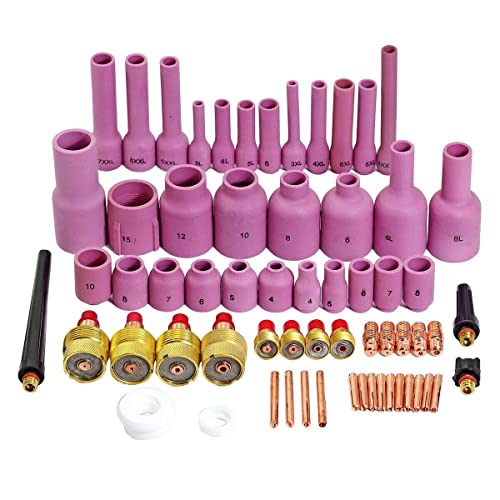
Introducing a versatile TIG welding kit that is compatible with a wide range of air-cooled and water-cooled torches. This kit is designed to fit all 9 series air-cooled torches and 20 series and 25 series water-cooled torches, including popular models like the Lincoln PTA-9, PTA-20, and PTA-25 torches, Miller Diamondback DB9, DB20, and DB26 torches, as well as the Weldcraft WP-9, WP-20, and WP-25 torches.
The kit includes 3 TIG back caps and 2 gas gaskets to ensure a secure and leak-free connection. Additionally, the kit comes with 31 TIG alumina nozzle cups, which are essential components for achieving precise and clean welds. With these high-quality nozzle cups, users can achieve optimal gas coverage and minimize unwanted oxidation.
The kit also comes with 14 TIG collets, which are used to hold the tungsten electrode in place during welding. These collets are made from durable and reliable materials to ensure a stable arc and consistent weld quality. Moreover, the kit includes 13 TIG gas lenses and collet bodies, which are used to create a smooth and steady gas flow during welding. These components are essential for creating a stable arc and minimizing weld defects.
10. Riverweld Tig Torch Part Variety Kit
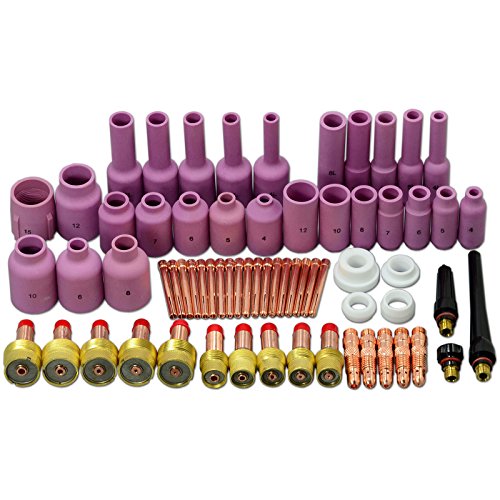
The Fit QQ300 DB PTA SR WP CK 17 18 26 TIG Welding Torch is a versatile and high-quality welding torch that is ideal for a wide range of welding applications. This durable and reliable torch is made from high-quality materials, and is designed to provide excellent performance and precision, even in the most demanding welding environments.
In addition to the torch itself, this package also includes a range of essential accessories, including 27pcs TIG Alumina Nozzle Gas Lens Ceramic Cups, 18pcs TIG Collets, and 5pcs TIG Collet Bodies. These accessories are designed to enhance the performance of the torch, and to help ensure that your welding projects are completed with precision and accuracy.
The package also includes 5pcs TIG Collet Lens and 5pcs L.G. TIG Gas Lens Collets Body, which are essential components for welding with a TIG torch. These components help to ensure that the welding arc is stable and consistent, and that the welds are strong and durable.
To further enhance the performance and versatility of this welding torch, the package also includes 3pcs TIG back cap and 4pcs Gas Lens Gasket Cup Inset back insulator. These components help to protect the torch from damage, and to ensure that it is always ready to perform at its best.
Best Gas For Tig Welding FAQs
Can I use argon for TIG welding aluminum?
Yes, argon is commonly used as a shielding gas for TIG welding aluminum. Argon provides excellent protection against atmospheric contamination that can cause defects in the weld, such as porosity and brittleness.
In TIG welding, a non-consumable tungsten electrode is used to create an arc that melts both the aluminum base metal and a filler rod. The argon gas is then used to shield the molten metal from the surrounding air, preventing oxidation and contamination of the weld.
Argon is preferred over other gases such as helium because it produces a more stable arc, which results in better control over the weld puddle and less spatter. It is also less expensive than helium, making it a more cost-effective option for TIG welding aluminum.
It is important to note that the purity of the argon gas used is critical to achieving high-quality welds. Argon gas with a purity of 99.996% or higher is recommended for TIG welding aluminum.
Can I use CO2 for TIG welding?
No, CO2 (carbon dioxide) cannot be used for TIG (tungsten inert gas) welding. TIG welding requires an inert gas, such as argon or helium, to shield the weld pool from atmospheric contamination. CO2 is not an inert gas and will not provide the necessary protection for the weld.
CO2 is commonly used for MIG (metal inert gas) welding, which is a different type of welding process that utilizes a consumable wire and a shielding gas to join two pieces of metal. MIG welding is typically used for thicker materials and is more suited for high production applications.
It is important to use the correct gas for the welding process you are using in order to achieve a high-quality weld. Using the wrong gas can result in poor weld quality, porosity, and other defects. Always consult the welding equipment manufacturer's specifications and guidelines to ensure you are using the appropriate gas for your application.
Can I use nitrogen for TIG welding?
Yes, nitrogen gas can be used for TIG (Tungsten Inert Gas) welding, but it is not commonly used as a shielding gas. TIG welding requires a shielding gas to protect the weld area from atmospheric contamination and to provide an inert atmosphere that will not react with the weld pool. Argon is the most commonly used shielding gas for TIG welding, and it provides good weld quality and control.
Nitrogen can be used as a shielding gas for TIG welding in certain situations, such as when welding stainless steel or when higher heat input is required. However, it is less commonly used due to its tendency to cause porosity in the weld and its potential to react with certain metals.
Ultimately, the choice of shielding gas for TIG welding will depend on the specific application and the desired results. It is important to consult with a welding professional to determine the best gas for your particular welding needs.
Is pure argon or a mix of argon and helium better for TIG welding?
When it comes to TIG welding, both pure argon and a mix of argon and helium can be used. However, the choice between the two depends on the specific requirements of the welding job.
Pure argon is a popular choice for TIG welding because it provides good weld quality and is suitable for a wide range of metals, including steel, aluminum, and stainless steel. It also has a lower ionization potential than helium, which means that it creates a more stable arc and easier starts.
On the other hand, a mix of argon and helium can provide higher heat input, which is useful for welding thicker metals. Helium also has a higher thermal conductivity than argon, which means that it can help to dissipate heat more quickly, resulting in less distortion of the welded metal.
Ultimately, the choice between pure argon and a mix of argon and helium depends on the specific welding job and the requirements for weld quality, heat input, and distortion control. It's important to consult with a welding expert or refer to welding guidelines to determine the best gas for your particular application.
What are the advantages and disadvantages of using different gases for TIG welding?
Tungsten Inert Gas (TIG) welding is a popular welding technique used in various industries. The use of different gases in TIG welding can have both advantages and disadvantages.
Argon is the most commonly used gas for TIG welding. It is an inert gas, which means it does not react with the metal being welded. Argon provides a stable arc, excellent weld quality, and helps prevent oxidation of the weld. However, it can be expensive compared to other gases used in TIG welding, and it may not be suitable for all types of metal.
Helium is another gas used in TIG welding. It has a higher heat input than argon, which means it can be used to weld thicker materials. Helium also provides a hotter arc, which can result in deeper penetration and faster welding speeds. However, it can be more difficult to control than argon, and it is also more expensive.
Other gases such as nitrogen, hydrogen, and carbon dioxide can also be used in TIG welding. Nitrogen can be used to increase the depth of penetration, but it can also cause porosity in the weld. Hydrogen can also increase penetration, but it can cause hydrogen embrittlement, which can weaken the weld. Carbon dioxide can be used in combination with argon to reduce costs, but it can also cause spatter and porosity.
In conclusion, the advantages and disadvantages of using different gases for TIG welding depend on the specific welding application and the type of metal being welded. It is important to choose the appropriate gas based on the desired weld quality, welding speed, and cost-effectiveness.
What gas should I use for TIG welding copper?
When it comes to TIG welding copper, the best gas to use is argon. Argon is a popular choice for TIG welding because it is an inert gas that doesn't react with the metal being welded. This makes it perfect for welding copper, which is a very reactive metal that can easily oxidize if exposed to air. Argon also has a high thermal conductivity, which helps to transfer heat to the weld area and create a stable arc. Another benefit of using argon is that it produces a clean and smooth weld bead with minimal spatter. When welding copper, it's important to use a pure argon gas with a minimum purity of 99.996%. This ensures that there are no impurities in the gas that can affect the quality of the weld. Overall, using argon gas for TIG welding copper is the best choice for achieving high-quality and consistent results.
What gas should I use for TIG welding mild steel?
For TIG welding mild steel, typically argon gas is used. Argon is an inert gas that is commonly used in welding as it helps to create a stable arc and produces a clean weld. When welding mild steel, a pure argon gas or a mixture of argon and carbon dioxide can be used. The ratio of argon to carbon dioxide in the gas mixture can vary depending on the thickness of the steel being welded. For thinner mild steel, a higher percentage of argon is recommended, while for thicker steel, a higher percentage of carbon dioxide is suggested. It is important to consult the manufacturer's recommendations for the specific welding machine being used to determine the optimal gas mixture. Using the correct gas for TIG welding mild steel will help to ensure a high-quality weld with good penetration and minimal spatter.
What is the best gas flow rate for TIG welding?
The gas flow rate is an important factor in TIG welding. It is recommended to use a gas flow rate of 20-25 cubic feet per hour (CFH) for TIG welding. This rate is sufficient to provide proper shielding to the weld area and prevent oxidation.
However, it is important to note that the gas flow rate may vary depending on the thickness and type of material being welded. Thicker materials may require a higher flow rate to ensure proper shielding, while thinner materials may require a lower flow rate to prevent turbulence and distortion.
It is also important to ensure that the gas flow rate is consistent throughout the welding process to maintain a stable arc and prevent contamination. Using a flow meter can help in accurately controlling the gas flow rate and ensuring consistent shielding.
Overall, it is important to follow the manufacturer's recommendations and perform a test weld to determine the optimal gas flow rate for a specific welding application.
What is the best gas for TIG welding stainless steel?
The best gas for TIG welding stainless steel is argon. Argon is a noble gas that is inert and does not react with the metal being welded. It provides excellent shielding properties and helps to prevent oxidation and contamination of the weld.
While some welders may use a mixture of argon and helium for TIG welding stainless steel, argon is generally preferred since it is more readily available and less expensive. Additionally, a mixture of argon and helium can be more difficult to control and may result in a less consistent weld.
It is important to note that the purity of the argon used for TIG welding stainless steel should be at least 99.996%. This high level of purity helps to ensure that the gas provides adequate shielding and does not introduce any contaminants into the weld.
Overall, using argon gas for TIG welding stainless steel is the best option for achieving high-quality, clean welds.
What is the difference between argon and helium for TIG welding?
Argon and helium are both inert gases that can be used for TIG (Tungsten Inert Gas) welding. However, there are some differences between these gases that make them better suited for different applications.
Argon is the most commonly used shielding gas for TIG welding. It is relatively inexpensive and provides good arc stability and penetration. Argon is also heavier than air, so it stays close to the weld pool and helps to prevent oxidation and contamination of the weld. Argon is a versatile and reliable gas that can be used for a wide range of materials, including steel, stainless steel, aluminum, and titanium.
Helium, on the other hand, is lighter than air and provides a hotter arc than argon. This makes it ideal for welding thicker materials, such as aluminum and copper, which require a higher heat input. Helium also provides better heat dissipation than argon, which can help to prevent warping and distortion of the workpiece. However, helium is more expensive than argon and can be more difficult to control, especially for less experienced welders.
In summary, argon is a reliable and versatile choice for TIG welding, while helium is better suited for welding thicker materials that require a higher heat input. Deciding which gas to use will depend on the specific application and the welder's skill level.
